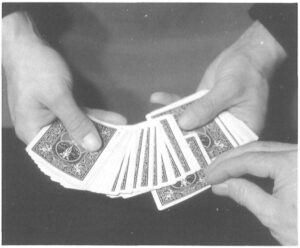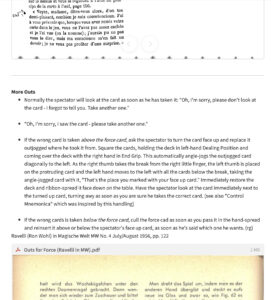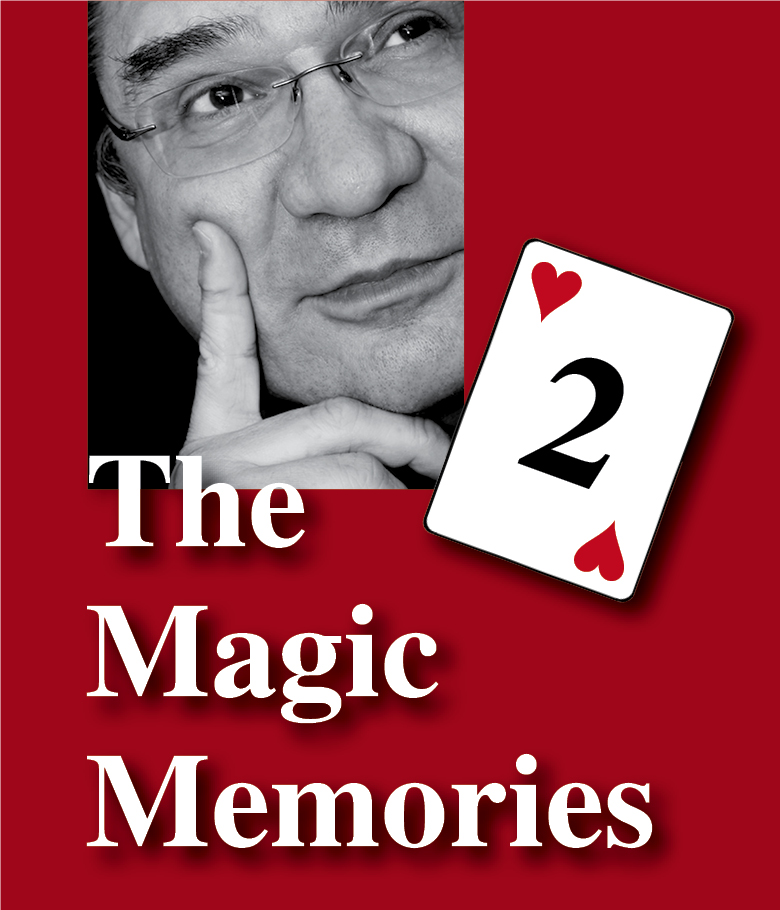
Hello everyone!
In this fifth installment of The Magic Memories let’s discuss the Classic Force. Just one aspect of it: what to do if it fails? In other words, we’ll talk outs. As you’ll see this implicitly means making it (almost) unfailing.

For the benefit of those who would like to review the sleight, here are a few sources where I have previously discussed the Classic Force:
- Book: Card College Volume 1 – Chapter 15, pp. 217 (in the updated German version its Grosse Kartenschule Band 2, pp. 313)
- Book: Stand-up Card Magic, “Classic Force Light”, pp. 65
- DVD-Download: Card College 1&2 – Personal Instruction – Lesson 16, The Force 2 (you can buy this lesson individually for a mere € 4.95 HERE)
- Book: Hidden Agenda , entries of July 8th, 9th, 10th and 11th
Welcome back.
Once you’ve understood and mastered the mechanics of the force, also its timing, and absorbed its underlying psychological principles (that’s a lot already!), you’ll find that more than most other sleights the Classic Force depends on experience, i.e. you cannot just practice it at home and in front of a mirror and camera as you could a Zarrow Shuffle or an Elmsley Count, but you’ve got to do it for real people. In Corona times this is a problem. A remedy: take a thick book, Hilliard’s Greater Magic preferred, place it near the edge of a table with the pages towards you, approach the book as if it was a spectator, and then force it/him/her the card by shoving it into its pages – you can do this sitting or standing (better!). The experience is much better than it reads.
So, once you can do that smoothly, you’ll find that the only hurdle to overcome is…fear! Yes, the fear of failing. The first and foremost way of overcoming the fear is as always: understand and practice, or as the Zen Master said:
“Before you practice, understand. Once you’ve understood, practice.”
Also, apply Ascanio’s strategy to reach mastery (see “Studying a Card Trick”, pp. 477 in Card College 2), i.e. use the technique in the context of a trick for a while, then reread and rethink the original instruction, and other instructions of the same I might add, and then retrain and apply with the new insights. Repeat until “internalization and full command” is reached (this is the step before “perfection”).
A positive aspect of the Classic Force is that its “In-flagranti Degree” is very low. In flagranti, from Latin, means being caught red-handed, in the act of doing something. To wit: the In-flagranti Degree of the Palm is very hight (degree 3 of 3), because if you’re caught with a card in your hand you have no out (well, maybe you say, “Oh, look at that, my sweaty hands, everything sticks to it…” – works in summer…). With the Classic Force, though, no problem. If it works and they say you made them take that card, they can’t prove it, and you can always say, “Oh, I wish I could do that”, or, “Nonsense, anyway, I have a 3-days-back-guarantee, you can return the card and take another one.” And now you perform another trick.
Which takes us to the core of this week’s topic, the Outs for the Classic Force (or any force that can fail).
First, if I may, and even if I may not, I’ll do it anyhow, since it’s my post and it’s free 🙂 realize that this is a big subject, a concept within a concept (reminds us of fractals, doesn’t it). Whenever I identify an idea as a concept, I open a new note in my electronic notebook, in my case that’s Evernote. This simplest way is to then make a list of all the outs you know and those you find by research (check your books, ask friends, ask the Internet, go to Behr’s Archives etc.): give it a title, and underneath describe the out in enough detail that you could send the note to someone and it would be understood. That’s a basic principle of note-taking.
Electronic notes have the advantage that you can also add a photo, a short video clip, a screen shot, a clip from the Internet, a voice message. A technique I use a lot is to add a PDF to the note. In this case I’d go to Card College 1, use a scan app (I use Readdle’s “Scanner Pro” for iOs) and take 3 photos of p. 222, 223 and 224, one after the other resulting in one PDF, not three jpgs. I can then annotate that extraction, even highlight, underline it etc. I will treat the subject of taking notes in a future post or in my Secret Newsletter, but below is a screenshot of a note for a taste. You can see it consist of text, links, and two PDF extractions, one from an old French book and one from a German magazine – the advantage of knowing six languages 🙂 My note about “Outs for the Classic Force” has close to one hundred entries 🙂 – yes, I know, I could write a book about the subject, but I won’t…

I don’t want to bore you with all those entries, so will just briefly discuss one category of outs, because, oh yes, the OUTS themselves have a taxonomy of their own – it’s really “outward simplicity hiding great complexity”, as Unamuno used to say (ya, ya, I’m repeating myself).
The category of outs I’m thinking of is “Out by Doing Another Trick”. I’m sure everyone knows that out, but here is my question to you: can you write down ten tricks you would and could do in such a situation? I mean right now, without going back to any note? In order to be able to react immediately and without apparent thinking when the force fails, have three tricks up your sleeve which you can do right away. And in order to have that, make a list of ten quick tricks, sometimes called “Quickies” in the specialized literature (magical, I mean).
Again, this is a big subject, so it deserves a note, or even a whole notebook. My current list has 92 items, however, some single items, as you can see in the screenshot below, refers to a complete publication with dozens of “quickies” e.g. Ed Marlo’s Discoveries from 1946, so the total number of tricks I’ve collected under this heading exceeds one hundred by far.

The “greenish” text is an internal link to another note, where the trick is described in detail. The “grayish” fields denote a PDF of the text or even the complete publication which contains the item.
To get you going here is a pick of ten items from my big list, for your convenience. However, I encourage you to make up your own list, based on your own repertoire and your own books, magazines and videos.
1. “Applause!”(by Marconick: the selection on top of tabled deck is bent upwards at its inner side. Both hands held on the tabletop join for a clapping, the air flipping the selection over à la “Acrobatic Card”).
2. “There is is” (from Hugard’s & Braue’s Expert Card Technique)
3. “The Question is?” (by Karrell Fox, see Card College 1, p. 81)
4. “Gymnastic Card” (production of selection à la LePaul’s “Gymnastic Aces” from his The Card Magic of Paul LePaul).
5. “Card in the Glass” (by Vanni Bossi, see Card College 3, p. 731)
6. “A Card in Hand” (by Annemann, see Card College 1, p. 133)
7. “Revelation with Benzai Slip Cut” (by John Benzais, see Card College 1, 116)
8. “Rub-a-dub-dub” (in Hugard’s & Braue’s Expert Card Technique)
9. “Gun Trick” (Peter Kane’s “Shooting Joker Production”, see Card College 3, p. 695)
10. “Spooky Revelation” (by Steve Draun, in Secrets Draun From Underground, p. 53)
Last Word (for today…)
So, without intention, this has also become a short lesson in how to take notes (to be added to what I already wrote on the subject in my Secret Newsletters #6 and Secret Newsletters #9 – access all Secret Newsletters BY CLICKING HERE. This is enough work for the next week, provided you can resist the temptations of Internet and all that new stuff publicized on a daily basis…don’t trade true progress with novelty.
Keep up the enthusiasm!


Danke, danke, danke. So viele, immer wieder wichtige und großartige Informationen. Und ich lerne nebenbei noch, wie ich Evernote sinnvoll einsetzen kann. Danke, Roberto!